Answer these simple questions and we will find you the BEST prices
Which type of solar quotes do you need?
It only takes 30 seconds
100% free with no obligation

Get Free quotes from insulation specialists near you

Save money by comparing quotes and choosing the most competitive offer

The service is 100% free and with no obligation
- GreenMatch
- Insulation
- Floor Insulation
- Vinyl Flooring Insulation
Insulation Under Vinyl Flooring: How Does It Work?

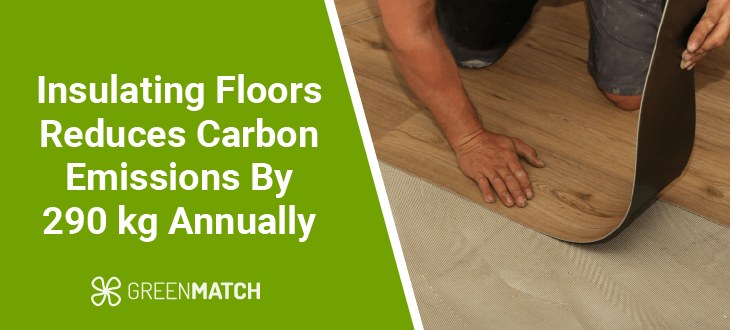
- Insulating the ground floor can save homeowners around £60 per year in Great Britain and approximately £85 per year in Northern Ireland.
- Insulating floors can reduce carbon emissions by about 290 kg of CO2 per year for a detached home.
- Insulation improves a home’s energy efficiency, helping to achieve the U-value requirement of 0.25 W/m²K in England and Wales, which minimises heat loss.
Vinyl flooring lacks insulation properties, but various underlay materials, such as foam, cork, and rubber, can improve warmth, noise reduction, and moisture control.
According to the Energy Saving Trust, floor insulation can lead to significant cost savings and improved home energy efficiency. By insulating the ground floor, homeowners in Great Britain can save around £60 per year, while those in Northern Ireland can save approximately £85 per year.
Additionally, those living in detached houses may save up to £100 per year in Great Britain and £145 per year in Northern Ireland.
This guide will provide an in-depth explanation of how insulation works under vinyl flooring. It will outline the types of available insulation, their benefits, and how they contribute to energy efficiency and comfort. Understanding these aspects will help you make informed decisions about your insulation project.
Why wait to start saving on energy bills and enjoying a cosier home? Click the button below to receive up to 3 free, personalised quotes from top-rated professional installers in your area. Take action now to ensure your floors are expertly insulated!
- Describe your needs
- Get free quotes
- Choose the best offer
It only takes 30 seconds



Can vinyl flooring be insulated?
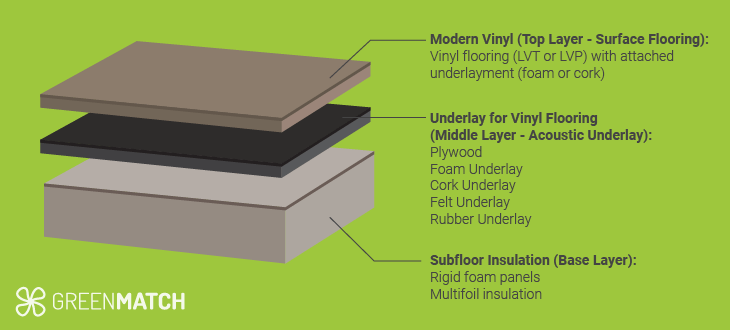
While vinyl flooring lacks natural insulation properties, adding insulation under vinyl flooring can improve warmth and comfort in a room. However, this can be tricky, as vinyl requires a hard, even surface for installation.
Vinyl floors are designed to be laid on solid foundations like concrete or wood; if the underlying surface is uneven or too soft, the flooring may buckle, warp, or tear over time.
In contrast, thinner, more rigid insulation solutions like EcoTec FloorFoam are designed to address this issue. EcoTec FloorFoam, a 4mm dense foam with reflective foil, provides thermal insulation and moisture control. However, to ensure the floor stays even, installing a thin plywood layer (3-4mm thick) on top of the insulation before laying the vinylis recommended. Another effective option is QuietWalk underlayment, which enhances insulation and offers a stable surface for vinyl flooring.
By selecting the right floor insulation in the UK, homeowners can enjoy both comfort and durability, even in colder climates, without compromising the quality of the flooring.
Options for insulation under vinyl flooring
This section will explore three main methods for insulating vinyl floors. The first is underlay for vinyl flooring, which includes various materials such as foam, cork, felt, and rubber. Next, we will look at subfloor insulation, a more permanent approach for installing insulation beneath the floorboards.
Finally, we will cover modern vinyl floors with attached underlayment, a convenient option where the insulation is built into the vinyl flooring, simplifying installation. Each method offers unique solutions for improving your floor's comfort and energy efficiency.
Underlay for vinyl flooring
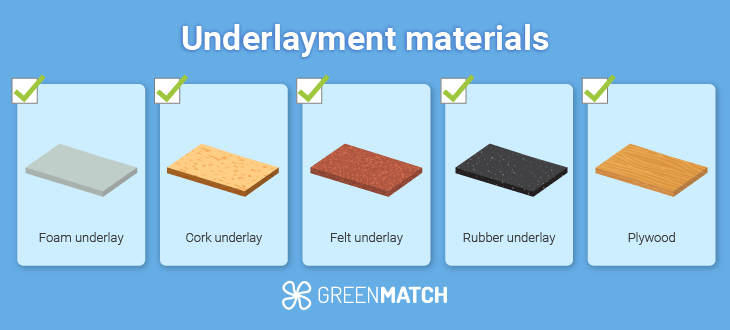
Underlayment is a crucial component when installing vinyl flooring. It provides various benefits, including thermal insulation, soundproofing, and added comfort underfoot. Several underlay materials are available, each suited to different needs and budgets.
Foam underlay
Foam underlay is one of the most common choices for vinyl flooring insulation due to its affordability and ease of installation. Foam is typically lightweight and provides good soundproofing and thermal insulation. For example, EcoTec FloorFoam is a 4mm thick high-density foam underlay with reflective aluminium layers that help retain heat and prevent drafts, making it ideal for concrete or timber subfloors.
Cork underlay
Cork underlay is a natural, eco-friendly option with excellent soundproofing and moderate thermal insulation. It is often used in homes where noise reduction is essential, such as multi-story buildings. Cork is also naturally resistant to moisture and mould, making it a good choice for kitchens and bathrooms.
Felt underlay
Felt underlay is thicker and denser than foam, offering better durability and insulation. It provides higher comfort and soundproofing, making it suitable for areas with heavy foot traffic. Felt also absorbs more sound than foam, making it ideal for spaces where noise control is a priority.
Rubber underlay
Rubber underlay is one of the best options for soundproofing and durability. It is highly resistant to moisture and provides excellent support for vinyl flooring, making it suitable for high-traffic areas such as hallways and commercial spaces. Rubber also has anti-slip properties, adding an extra layer of safety.
Plywood
Plywood is not a traditional underlay material but is often used with softer materials like foam. A 3 - 4mm plywood layer is added to the foam underlay to create a more solid and even surface for vinyl installation. This is especially useful when the subfloor is uneven or unstable.
Subfloor insulation
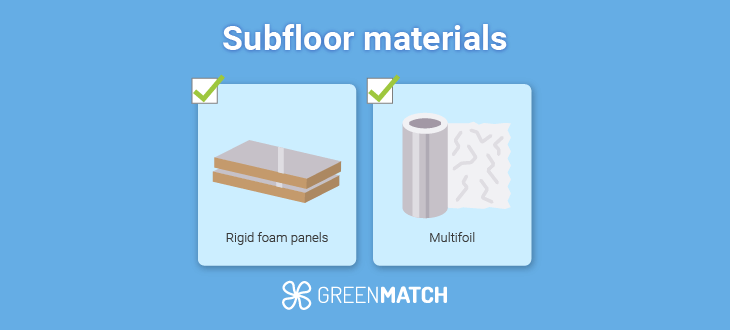
Subfloor insulation is a more permanent and effective solution for improving vinyl floor insulation. It involves placing insulation materials beneath the subfloor or floorboards, offering substantial energy savings by reducing heat loss through the floor. This type of insulation is ideal for homes where subfloors are accessible and where long-term insulation is a priority.
Common materials for subfloor insulation include rigid foam panels and multifoil insulation. These materials are designed to be installed beneath the existing subfloor and provide excellent thermal performance. Multifoil insulation, for instance, consists of several layers of reflective materials and wadding, which help to trap heat and prevent cold air from rising through the floor.
Modern vinyl floors
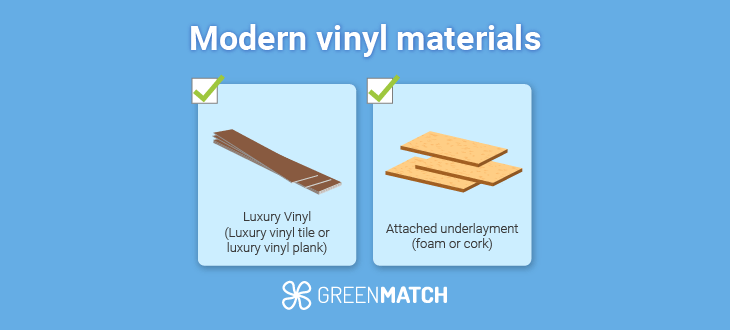
Modern vinyl flooring products often come with attached underlayments, making installation quicker and easier while providing built-in insulation, soundproofing, and moisture control. These vinyl flooring options, usually luxury vinyl tile (LVT) or luxury vinyl plank (LVP), eliminate the need for separate underlays, simplifying installation, especially for DIY enthusiasts.
Vinyl floors with attached underlayment typically feature layers of vinyl with a pre-attached underlayment. The underlayment adds comfort, absorbs sound, and provides additional moisture resistance. Foam underlayment helps soften the feel underfoot and improves sound absorption, while cork underlayment adds more warmth and a natural feel to the flooring.
Insulation costs comparison
When considering housing insulation options for your vinyl flooring, it's essential to compare the costs to find the best solution for your budget and needs. Below, we’ve created a table that outlines the costs of various insulation options, including underlays, subfloor insulation, and modern vinyl with built-in underlay. This will help you compare and choose the most cost-effective method for your home.
| Type of insulation | Cost per square metre |
|---|---|
| Foam underlay | £5 - £7 |
| Cork underlay | £8 - £15 |
| Felt underlay | £7 - £12 |
| Rubber underlay | £10 - £20 |
| Plywood layer | £10 - £15 (per sheet) |
| Subfloor insulation | £10 - £20 |
| Vinyl floors with attached underlayment | £25 - £40 |
Grant options
You may qualify for a grant through the UK government’s Energy Company Obligation (ECO) scheme. This scheme offers free or reduced-cost insulation for suspended wooden floors, helping keep your home warm and reduce heating costs.
You can also apply for grants to insulate other areas of your home, such as lofts and walls. Eligibility requirements can change, so it's worth checking if you qualify for funding.
Professional installation is key for the best results and long-term savings. In just 30 seconds, you can receive up to 3 free quotes from trusted local installers. Click the button below to get started!
- Describe your needs
- Get free quotes
- Choose the best offer
It only takes 30 seconds



Which vinyl floor insulation is best?
There isn’t a definitive "best" option for vinyl floor insulation, as the choice depends on your needs. However, foam underlay, like EcoTec FloorFoam, is a solid choice for many homes. It’s cost-effective, easy to install, and provides thermal insulation and moisture protection, making it a good option for concrete or timber subfloor.
How to install insulation under vinyl flooring
Installing insulation under vinyl flooring involves a few straightforward steps to ensure proper coverage, stability, and thermal benefits:
- Prepare the subfloor: Ensure the subfloor is clean, dry, and smooth. Remove any debris to create a stable base for the underlay.
- Roll out the underlay: Cut the underlay to fit the space and lay it flat, ensuring no overlaps. Cut around any obstructions like pipes.
- Secure the underlay: Use staples or double-sided tape to fix the underlay to the subfloor. Seal the seams with aluminium tape to prevent drafts.
- Lay plywood (if needed): For added stability, install a 3-4mm plywood layer on top of the foam underlay.
- Install vinyl flooring: Lay the vinyl on top of the secured underlay according to the manufacturer’s instructions.
Is vinyl floor insulation the right choice for your home?
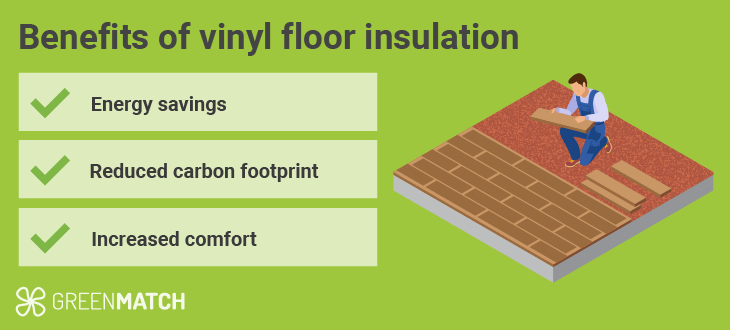
Adding insulation under vinyl flooring can bring numerous benefits, including energy savings, increased comfort, and environmental advantages. Here’s how vinyl floor insulation can impact your home:
Energy savings
A well-insulated floor can prevent heat loss, which is crucial in colder climates. According to the Energy Saving Trust, uninsulated floors can account for 10-20% of heat loss in a home.
Insulating your floors could save you up to £180 a year on energy bills for a detached house, with smaller savings in semi-detached or mid-terrace homes. This leads to long-term reductions in heating costs and overall energy consumption.
Environmental benefits
Insulating your floors not only saves energy but also reduces your carbon footprint. According to UK-based One Home Climate Solutions, properly insulated floors can save approximately 290 kg of CO2 per year in a typical detached house. This reduction in emissions helps lower your overall environmental impact.
Increased comfort
Insulated floors make your home more comfortable, especially in colder months. Vinyl flooring with proper insulation feels warmer underfoot and reduces cold drafts, making your living space more enjoyable year-round.
Choosing the right insulation depends on factors like your subfloor type and budget.
Consulting a professional installer can help you select the best floor insulation solution for your home while complying with UK building regulations.
The UK’s Energy Saving Trust echoes this and notes that hiring a professional installer for floor insulation ensures compliance with floor insulation building regulations, such as achieving a U-value requirement of 0.25 W/m²K or less in England and Wales, which can contribute to long-term energy savings and improved home efficiency.
Contact a professional installer and start saving on energy bills while improving the warmth and durability of your floors! We'll connect you with up to 3 free, customised quotes from trusted professional installers in your area. Click on the button below to get started!
- Describe your needs
- Get free quotes
- Choose the best offer
It only takes 30 seconds



FAQ
Yes, you can put insulation under vinyl flooring. However, choosing the right type of insulation that provides stability is essential, as vinyl flooring requires a firm surface for proper installation.
You can use an insulating underlay made from foam, cork, or rubber to keep your vinyl floor warm. These materials help retain heat and prevent cold drafts. If the subfloor is uneven, add a plywood layer on the insulation for extra support.
Foam underlay is not always required but can be beneficial. If your vinyl flooring doesn’t come with an attached underlay, installing a foam underlay can help improve its warmth and overall performance, especially over concrete subfloors.
The best material to put under vinyl flooring depends on your needs. Foam underlay is popular for comfort and insulation, while cork provides excellent soundproofing. A thin plywood layer is often recommended for uneven subfloors to create a smooth surface before installing the vinyl.

Nicole Bea Kerr is a content writer for Greenmatch, leveraging her experience in B2B journalism and editing. She is interested in bringing more awareness to sustainability through informative narratives.
We strive to connect our customers with the right product and supplier. Would you like to be part of GreenMatch?

- Describe your needs
- Get free quotes
- Choose the best offer
It only takes 30 seconds



